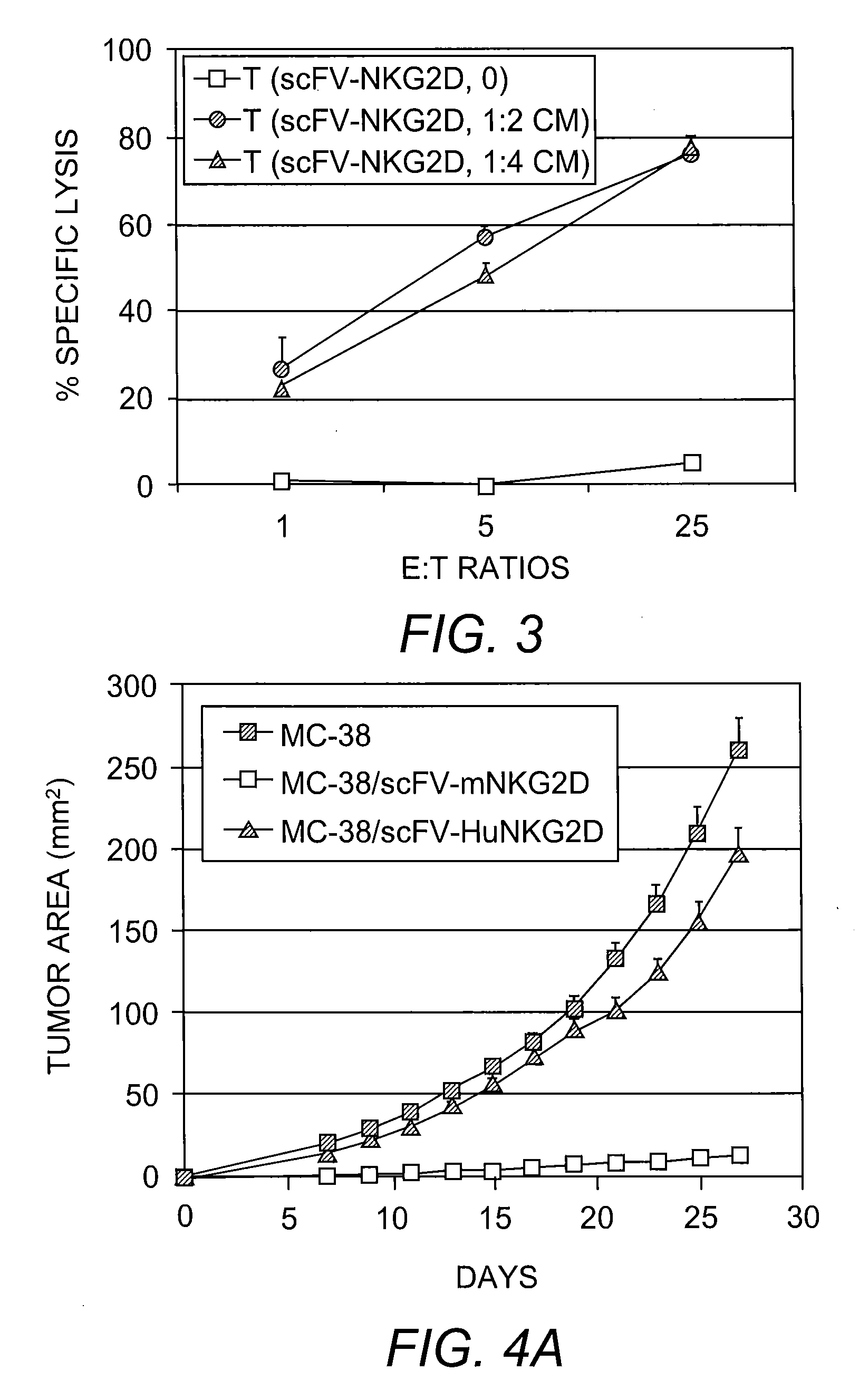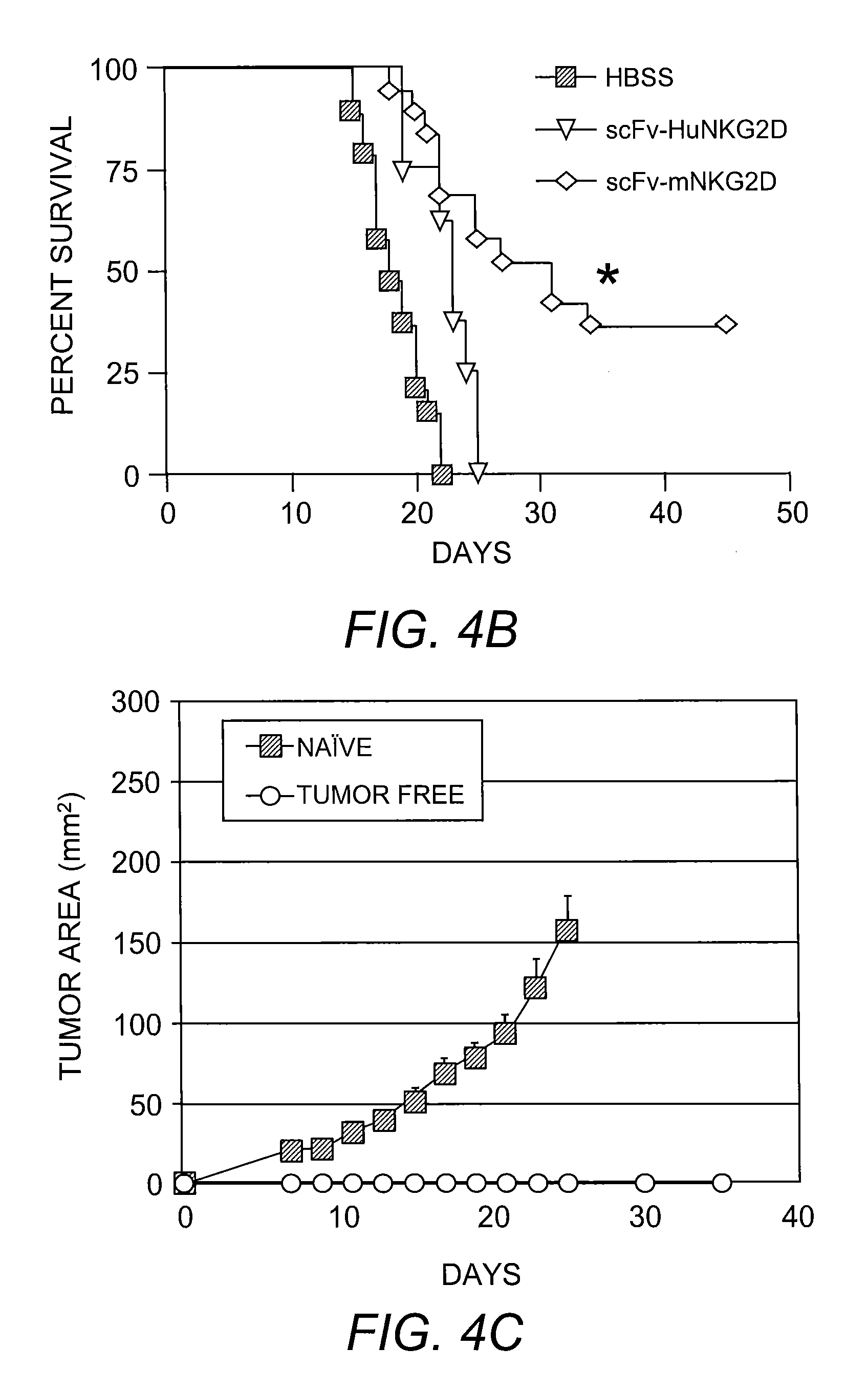Monomeric Bi-Specific Fusion Protein
a fusion protein and monomer technology, applied in the field of cytotoxic drugs, can solve the problems of time-consuming, laborious and sometimes difficult, and the isolation and expansion of t cells that retain their antigen specificity and function can also be a challenging task, so as to enhance immunity against a tumor
- Summary
- Abstract
- Description
- Claims
- Application Information
AI Technical Summary
Problems solved by technology
Method used
Image
Examples
example 1
Construction and Production of scFv-NKG2D
[0081]Bi-specific molecule scFv-NKG2D was generated using the anti-CD3ε binding Fv region fused to NKG2D (FIG. 1). The gene coding for the scFv portion of fusion protein scFv-NKG2D was constructed by PCR amplification of variable region of heavy chain (VH) and variable region of light chain (VL) using cDNA derived from an anti-mouse CD3ε hybridoma 2C11 (ATCC). VH and VL were linked using a flexible linker of three repeats of Gly-Gly-Gly-Gly-Ser (SEQ ID NO:10) ((G4S)3). Signal peptide (SP) from Ig heavy chain or other type I protein (such as Dap10) was also included at the 5′ end of the recombinant DNA. The gene coding for the extracellular portion of mouse NKG2D was PCR-amplified using wild-type full-length NKG2D plasmid as template (Zhang, et al. (2005) Blood 106 (5):1544-51). Both scFv and NKG2D portions were linked in-frame with a second (G4S)3 and cloned in a retroviral vector pFB-neo (STRATAGENE) and a mammalian expression vector pcDNA3....
example 2
Characterization of scFv-NKG2D
[0083]The activity of the scFv-NKG2D fusion protein was assessed. To demonstrate binding specificity, it was determined whether the fusion protein can bind to CD3. A T cell lymphoma cell line RMA (105, CD3+ NKG2D−), which does not express ligands for NKG2D, was stained with scFv-NKG2D (0.01-1 μg / ml) followed by staining with anti-NKG2D-PE. Samples were analyzed with an Accuri C6 flow cytometer and it was shown that the scFv-NKG2D fusion protein can bind to CD3.
[0084]To demonstrate activity, it was determined whether the fusion protein could induce IFN-γ secretion. Bulk spleen cells were stimulated with ConA and IL-2 before co-culture with irradiated tumor cells. The scFv-NKG2D was subsequently added and IFN-γ amounts in the supernatants were analyzed with ELISA. The results of this analysis indicated that T cells respond to NKG2D ligand positive cells by producing IFN-γ in the presence of scFv-NKG2D (FIG. 2). These data also show that the expression of ...
example 3
In Vitro Tumor Killing Activity of scFv-NKG2D
[0085]In addition to IFN-γ secretion, it was determined whether the scFv-NKG2D fusion protein could mediate tumor killing. ConA-stimulated T cells were co-cultured with NKG2D ligand-positive P815 / Rae1 in the presence or absence of scFv-NKG2D and specific lysis was determined. This analysis indicated that T cells can kill NKG2D ligand-positive tumor cells in the presence of scFv-NKG2D (FIG. 3).
PUM
| Property | Measurement | Unit |
|---|---|---|
| concentrations | aaaaa | aaaaa |
| nucleic acid | aaaaa | aaaaa |
| frequency | aaaaa | aaaaa |
Abstract
Description
Claims
Application Information
 Login to View More
Login to View More - R&D
- Intellectual Property
- Life Sciences
- Materials
- Tech Scout
- Unparalleled Data Quality
- Higher Quality Content
- 60% Fewer Hallucinations
Browse by: Latest US Patents, China's latest patents, Technical Efficacy Thesaurus, Application Domain, Technology Topic, Popular Technical Reports.
© 2025 PatSnap. All rights reserved.Legal|Privacy policy|Modern Slavery Act Transparency Statement|Sitemap|About US| Contact US: help@patsnap.com



